Abstract
Ventricular arrhythmias are common after repair of tetralogy of Fallot and are associated with late sudden death. This study examined the relation of ventricular arrhythmia during normal daily activities to the timing of repair, duration of follow up, and postoperative haemodynamic status. Forty eight hour ambulatory electrocardiographic monitoring was performed in 145 patients: 60 (aged 3 months to 46 years) had not yet undergone repair and 85 were followed from four to 22 (mean 14.6) years after repair. Cardiac catheterisation was performed in 47 (55%) one to 22 (mean 8.9) years after repair. Twelve (20%) of the uncorrected group had ventricular arrhythmia. The incidence increased significantly with age from 0% in patients aged less than 8 years to 58% in those aged greater than or equal to 16 years. In the corrected group 44% had ventricular arrhythmia. The incidence of arrhythmia was associated with older age at repair but not with postoperative haemodynamic status, duration of follow up, or era of surgery. It is concluded that ventricular arrhythmia is common in older patients with tetralogy of Fallot before repair and that during long term follow up of patients after repair the incidence of ventricular arrhythmia is influenced by the timing of surgery rather that the duration of postoperative follow up, era of surgery, or the haemodynamic result.
Full text
PDF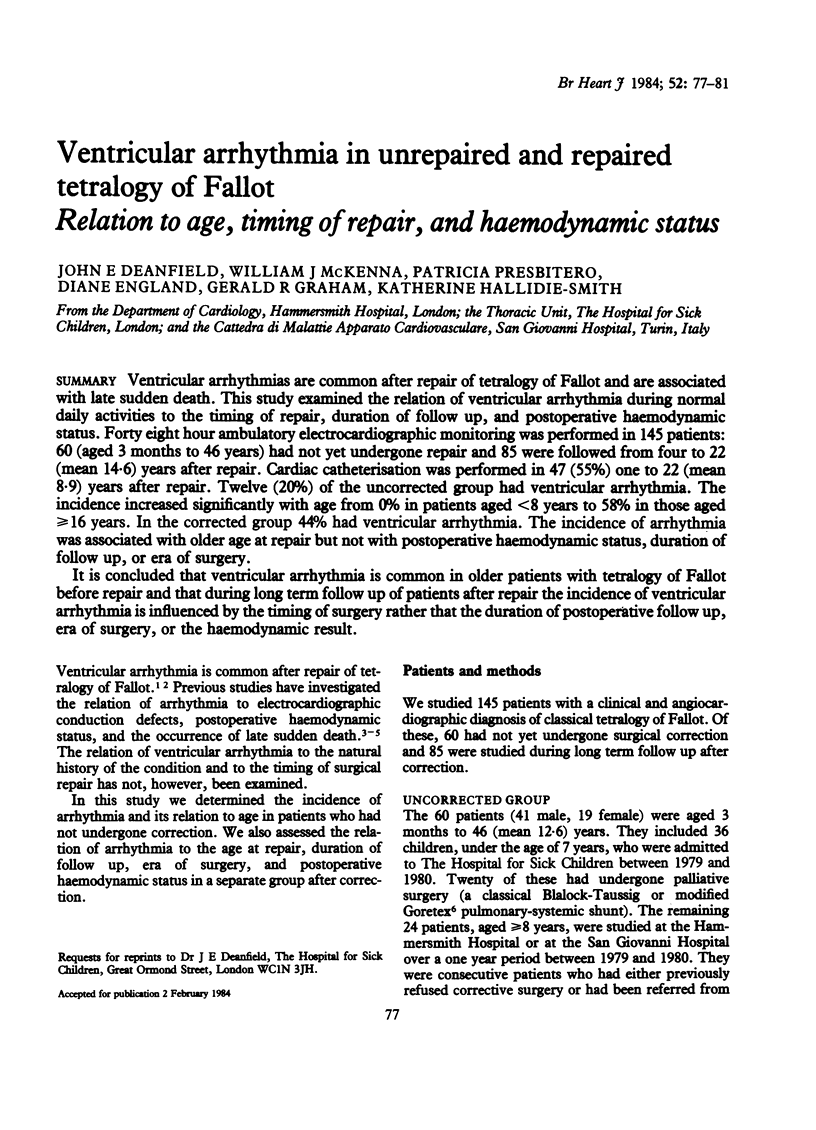
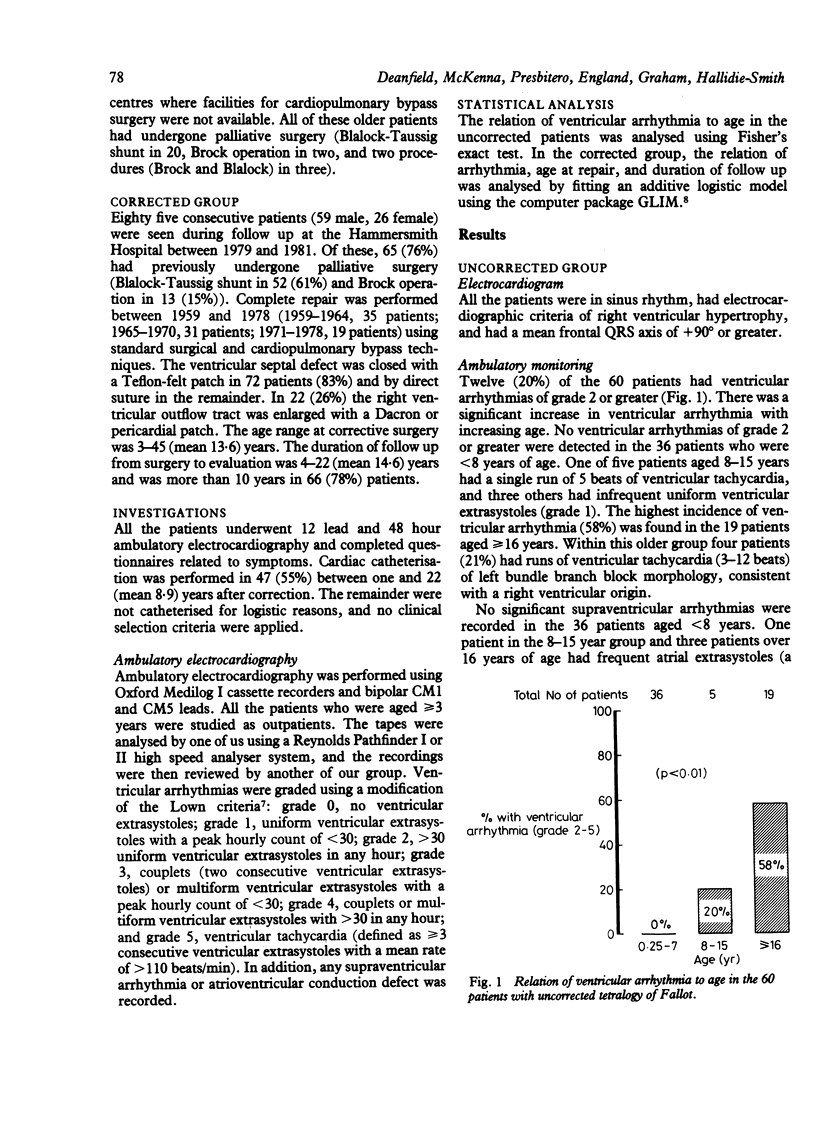
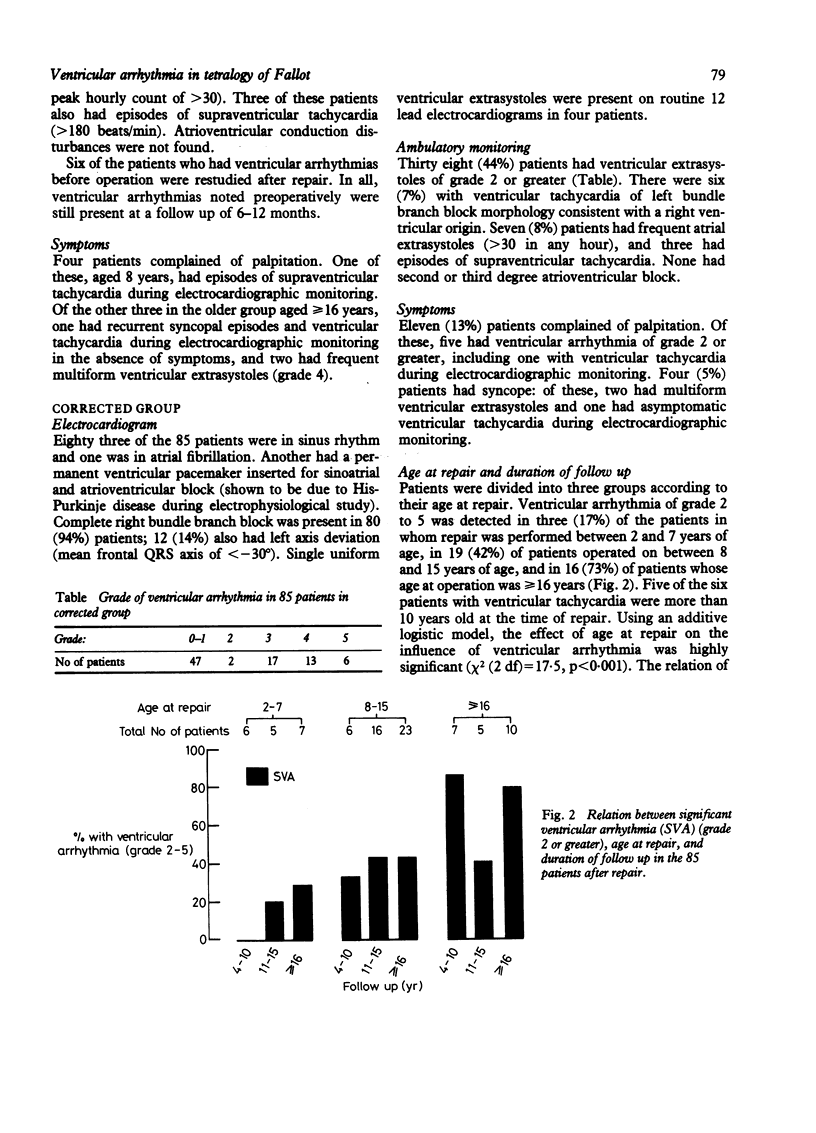
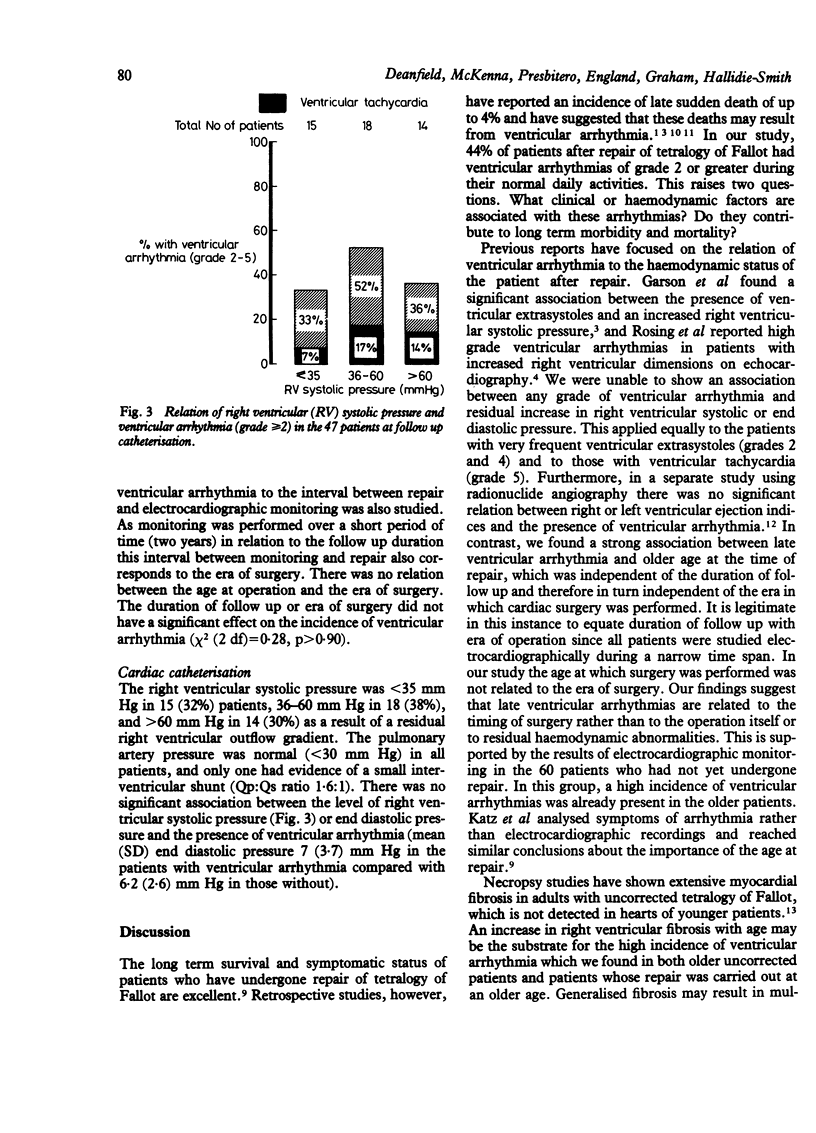
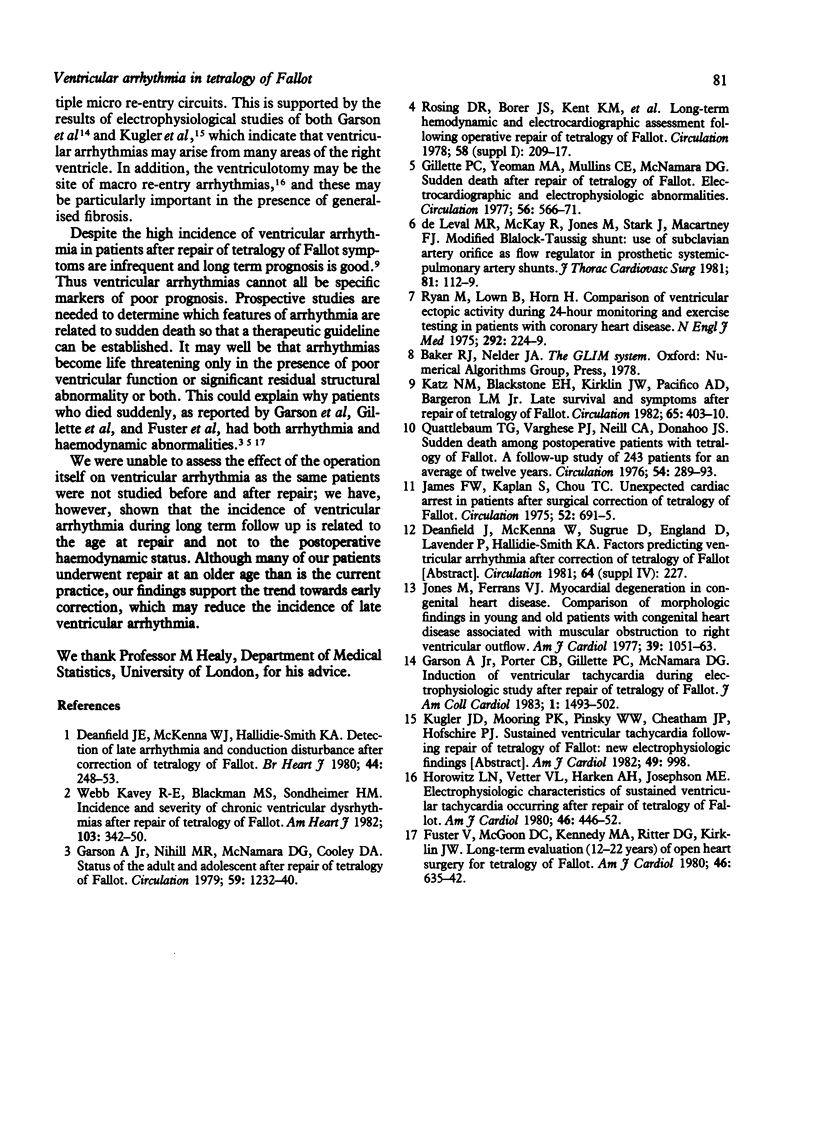
Selected References
These references are in PubMed. This may not be the complete list of references from this article.
- Deanfield J. E., McKenna W. J., Hallidie-Smith K. A. Detection of late arrhythmia and conduction disturbance after correction of tetralogy of Fallot. Br Heart J. 1980 Sep;44(3):248–253. doi: 10.1136/hrt.44.3.248. [DOI] [PMC free article] [PubMed] [Google Scholar]
- Fuster V., McGoon D. C., Kennedy M. A., Ritter D. G., Kirklin J. W. Long-term evaluation (12 to 22 years) of open heart surgery for tetralogy of Fallot. Am J Cardiol. 1980 Oct;46(4):635–642. doi: 10.1016/0002-9149(80)90514-7. [DOI] [PubMed] [Google Scholar]
- Garson A., Jr, Nihill M. R., McNamara D. G., Cooley D. A. Status of the adult and adolescent after repair of tetralogy of Fallot. Circulation. 1979 Jun;59(6):1232–1240. doi: 10.1161/01.cir.59.6.1232. [DOI] [PubMed] [Google Scholar]
- Garson A., Jr, Porter C. B., Gillette P. C., McNamara D. G. Induction of ventricular tachycardia during electrophysiologic study after repair of tetralogy of Fallot. J Am Coll Cardiol. 1983 Jun;1(6):1493–1502. doi: 10.1016/s0735-1097(83)80054-0. [DOI] [PubMed] [Google Scholar]
- Gillette P. C., Yeoman M. A., Mullins C. E., McNamara D. G. Sudden death after repair of tetralogy of Fallot. Electrocardiographic and electrophysiologic abnormalities. Circulation. 1977 Oct;56(4 Pt 1):566–571. doi: 10.1161/01.cir.56.4.566. [DOI] [PubMed] [Google Scholar]
- Horowitz L. N., Vetter V. L., Harken A. H., Josephson M. E. Electrophysiologic characteristics of sustained ventricular tachycardia occurring after repair of tetralogy of fallot. Am J Cardiol. 1980 Sep;46(3):446–452. doi: 10.1016/0002-9149(80)90014-4. [DOI] [PubMed] [Google Scholar]
- James F. W., Kaplan S., Chou T. C. Unexpected cardiac arrest in patients after surgical correction of tetralogy of Fallot. Circulation. 1975 Oct;52(4):691–695. doi: 10.1161/01.cir.52.4.691. [DOI] [PubMed] [Google Scholar]
- Jones M., Ferrans V. J. Myocardial degeneration in congenital heart disease. Comparison of morphologic findings in young and old patients with congenital heart disease associated with muscular obstruction to right ventricular outflow. Am J Cardiol. 1977 Jun;39(7):1051–1063. doi: 10.1016/s0002-9149(77)80221-x. [DOI] [PubMed] [Google Scholar]
- Katz N. M., Blackstone E. H., Kirklin J. W., Pacifico A. D., Bargeron L. M., Jr Late survival and symptoms after repair of tetralogy of Fallot. Circulation. 1982 Feb;65(2):403–410. doi: 10.1161/01.cir.65.2.403. [DOI] [PubMed] [Google Scholar]
- Kavey R. E., Blackman M. S., Sondheimer H. M. Incidence and severity of chronic ventricular dysrhythmias after repair of tetralogy of Fallot. Am Heart J. 1982 Mar;103(3):342–350. doi: 10.1016/0002-8703(82)90272-1. [DOI] [PubMed] [Google Scholar]
- Quattlebaum T. G., Varghese J., Neill C. A., Donahoo J. S. Sudden death among postoperative patients with tetralogy of Fallot: a follow-up study of 243 patients for an average of twelve years. Circulation. 1976 Aug;54(2):289–293. doi: 10.1161/01.cir.54.2.289. [DOI] [PubMed] [Google Scholar]
- Ryan M., Lown B., Horn H. Comparison of ventricular ectopic activity during 24-hour monitoring and exercise testing in patients with coronary heart disease. N Engl J Med. 1975 Jan 30;292(5):224–229. doi: 10.1056/NEJM197501302920502. [DOI] [PubMed] [Google Scholar]
- de Leval M. R., McKay R., Jones M., Stark J., Macartney F. J. Modified Blalock-Taussig shunt. Use of subclavian artery orifice as flow regulator in prosthetic systemic-pulmonary artery shunts. J Thorac Cardiovasc Surg. 1981 Jan;81(1):112–119. [PubMed] [Google Scholar]


